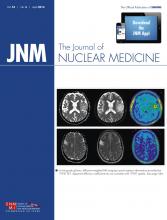Abstract
Radionuclide renal scintigraphy provides important functional data to assist in the diagnosis and management of patients with a variety of suspected genitourinary tract problems, but the procedures are underutilized. Maximizing the utility of the available studies (as well as the perception of utility by referring physicians) requires a clear understanding of the clinical question, attention to quality control, acquisition of the essential elements necessary to produce an informed interpretation, and production of a report that presents a coherent impression that specifically addresses the clinical question and is supported by data contained in the report. To help achieve these goals, part 1 of this review covers information that should be provided to the patient before the scan, describes the advantages and limitations of the available radiopharmaceuticals, discusses quality control elements needed to optimize the study, summarizes approaches to the measurements of renal function, and focuses on recommended quantitative indices and their diagnostic applications. Although the primary focus is the adult patient, aspects of the review also apply to the pediatric population.
- 99mTc-MAG3
- 99mTc-DTPA
- renal scintigraphy
- clearance
- renal function
- effective renal plasma flow
- glomerular filtration rate
- relative function
Footnotes
Published online Feb. 17, 2014.
Learning Objectives: On successful completion of this activity, participants should be able to describe (1) the advantages and limitations of the available radiopharmaceuticals for radionuclide renal scintigraphy; (2) quality control elements needed to optimize the study; (3) approaches to the measurements of renal function; and (4) recommended quantitative indices and their diagnostic applications.
Financial Disclosure: This review was partially supported by a grant from the National Institutes of Health (NIH/NIDDK R37 DK38842). Andrew T. Taylor is entitled to a share of the royalties for the use of QuantEM software for processing MAG3 renal scans, which was licensed by Emory University to GE Healthcare in 1993. He and his coworkers have subsequently developed in-house, noncommercial software that was used in this study and could affect their financial status. The terms of this arrangement have been reviewed and approved by Emory University in accordance with its conflict-of-interest policies. The author of this article has indicated no other relevant relationships that could be perceived as a real or apparent conflict of interest.
CME Credit: SNMMI is accredited by the Accreditation Council for Continuing Medical Education (ACCME) to sponsor continuing education for physicians. SNMMI designates each JNM continuing education article for a maximum of 2.0 AMA PRA Category 1 Credits. Physicians should claim only credit commensurate with the extent of their participation in the activity. For CE credit, participants can access this activity through the SNMMI Web site (http://www.snmmi.org/ce_online) through April 2017.
- © 2014 by the Society of Nuclear Medicine and Molecular Imaging, Inc.







